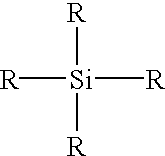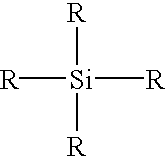Electron beam modification of CVD deposited films, forming low dielectric constant materials
- Summary
- Abstract
- Description
- Claims
- Application Information
AI Technical Summary
Benefits of technology
Problems solved by technology
Method used
Image
Examples
example 1
[0033]Deposition of fluorinated silicon dioxide film onto a silicon substrate is carried out in a PECVD reactor, while maintaining heating at between 345° C. and 400° C., a total pressure between 780 and 1000 mTorr and supplying between 73 to 100 watts of power to the plasma generating system. Electron beam exposure is then conducted in an ElectronCure™ 1200 chamber incorporating a large area electron source and quartz lamps for heating the wafer. The cold-cathode source produces a large area electron beam (over 200 mm in diameter) having a substantially uniform emission over its entire surface. Electron emission is controlled by the low bias voltage applied to the anode grid. Electron beam exposure was conducted at a temperature of 350° C. and in an argon atmosphere (10-30 milliTorr). The dose is 5,000 μC / cm2. The electron beam current is 30 mA. The energy is 20 keV. After removal from the tool, the dielectric layer has a dielectric constant of less than 3.
example 2
[0034]A 4″ silicon wafer is inserted into a cluster tool having interconnected CVD and electron beam exposure modules. A vacuum is applied through the entire tool including the electron beam exposure module. The wafer is transported into the CVD chamber and silane is allowed to flow into the CVD chamber. A dielectric film is deposited onto the wafer. The film thickness after the deposition process is approximately 5000 Å. Without breaking vacuum, the wafer is transported to the electron beam exposure module where it is exposed to electron beam radiation using a large area electron source while being heated by quartz lamps from below. The cold-cathode source produces a large area electron beam (over 200 mm in diameter) having a substantially uniform emission over its entire surface. Electron emission is controlled by the low bias voltage applied to the anode grid. Electron beam exposure was conducted at a temperature of 200° C. and in an argon atmosphere (10-30 milliTorr).
example 3
[0035]A thin film of Black Diamond™ inorganic F-doped SiO2, from Applied Materials, is formed on a 4″ silicon wafer using a HDP CVD. Deposition is conducted while heating at a temperature of 300° C. for three minutes. The film thickness after the deposition is approximately 5000 Å. Electron beam exposure is conducted in an ElectronCure™ 1200 chamber incorporating a large area electron source and quartz lamps for heating the wafer. The cold-cathode source produces a large area electron beam (over 200 mm in diameter) having a substantially uniform emission over its entire surface. Electron emission is controlled by the low bias voltage applied to the anode grid. Electron beam exposure is conducted at a temperature of 400° C. for three minutes in an argon atmosphere (10-30 milliTorr). The dose is 3000 μμ}C / cm2. The electron beam current is 20 mA. The energy is 5 keV. The layer has a dielectric constant of less than 3 and lower than a comparable layer which has been cured in a standard ...
PUM
| Property | Measurement | Unit |
|---|---|---|
| Temperature | aaaaa | aaaaa |
| Temperature | aaaaa | aaaaa |
| Temperature | aaaaa | aaaaa |
Abstract
Description
Claims
Application Information
 Login to view more
Login to view more - R&D Engineer
- R&D Manager
- IP Professional
- Industry Leading Data Capabilities
- Powerful AI technology
- Patent DNA Extraction
Browse by: Latest US Patents, China's latest patents, Technical Efficacy Thesaurus, Application Domain, Technology Topic.
© 2024 PatSnap. All rights reserved.Legal|Privacy policy|Modern Slavery Act Transparency Statement|Sitemap


